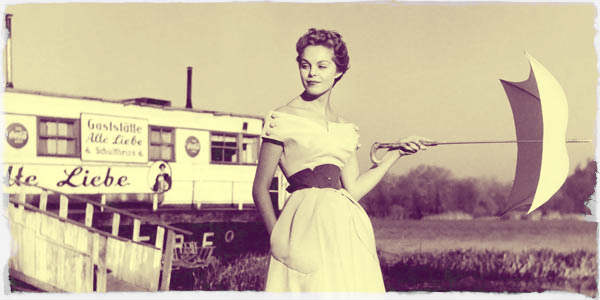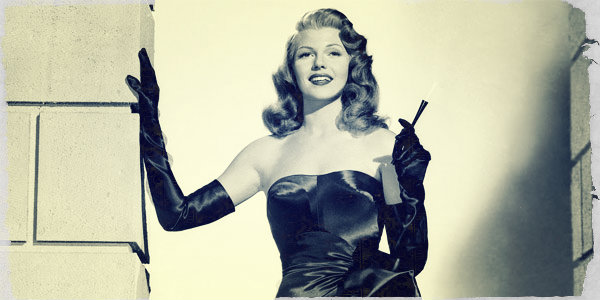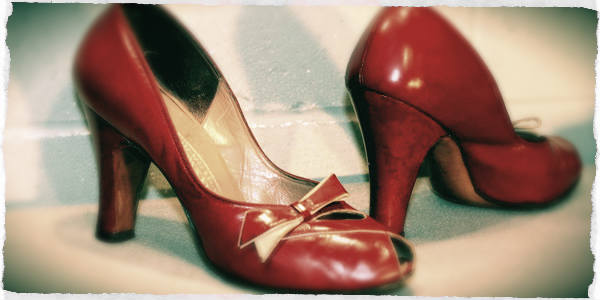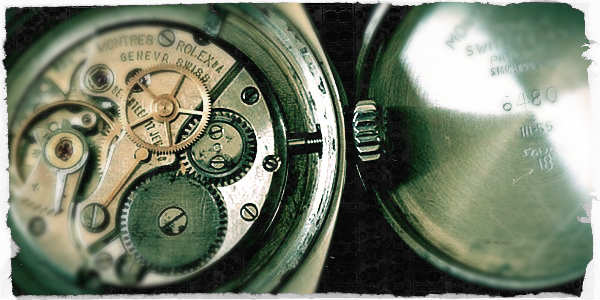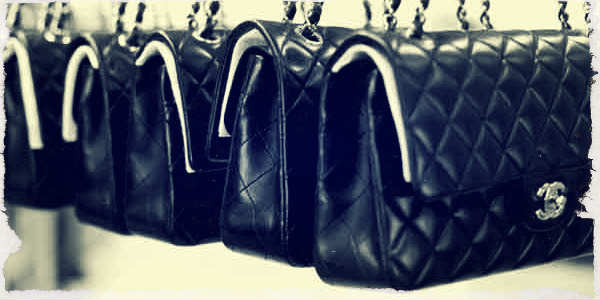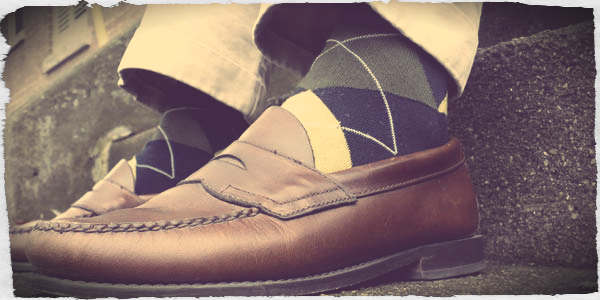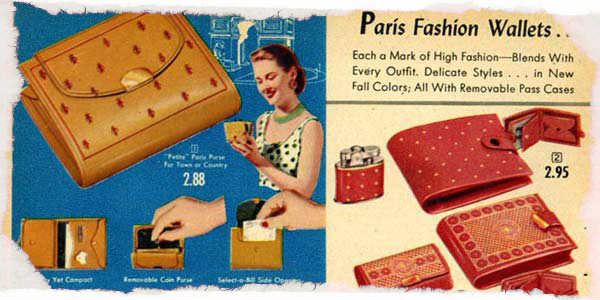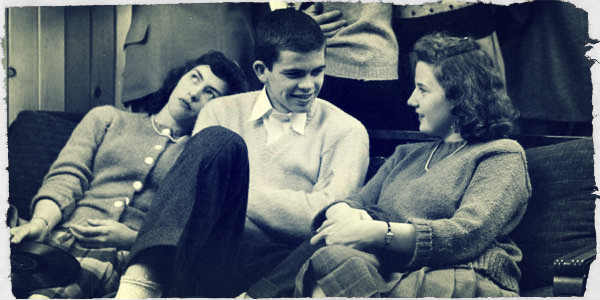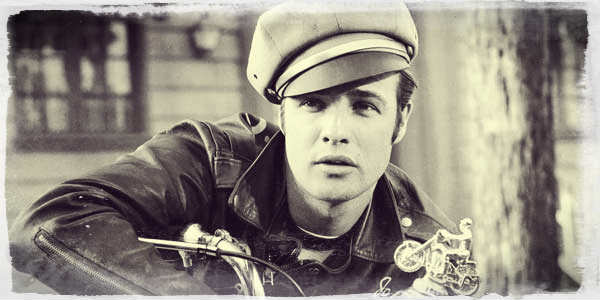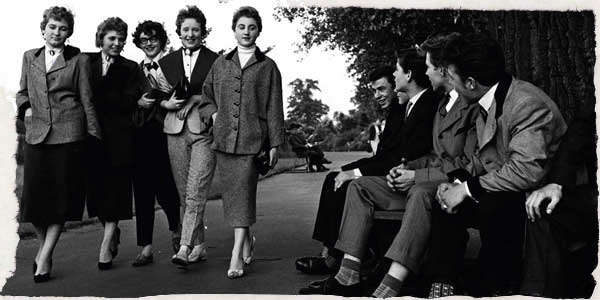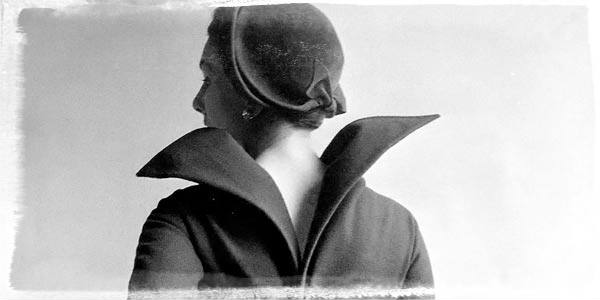
Fashion in the 1950s varied greatly from the beginning to end. Maybe not quite as extreme as the ’60s, 1950s fashion saw the introduction of many new styles as well as many styles that paid homage to the 1920s.
The important thing is that people were beginning to feel a little more freedom when it came to their fashion choices. No longer did people feel like they had to conform to a certain look for certain situations.
The first years after World War II might be regarded by fashion historians as a period of transition, a period of groping after the lines into which fashion would settle for an 8-year or 10-year span.
No final answer to questions about the waistline was given in 1952. The phrase “the wandering waistline” was coined at the Paris spring collections and the waist continued to wander to the point of disappearing, throughout the year.
1953 ushered in a mood of sleek, slender elegance — at once young and sophisticated. Hemlines, waistlines and hairlines all grew shorter in 1953. Buzzwords at the time were “shape” and “sheen.”
1957 was the year in which Gabrielle “Coco” Chanel (at age 74) became “an adjective in her own time.” Sort of like “Googling,” Chanel-isms were ubiquitous.
Want to learn how to dress 50s style? Keep reading below for a year-by-year breakdown spanning 1950-1959.
1950s Fashion Timeline
1950 | 1951 | 1952 | 1953 | 1954 | 1955 | 1956 | 1957 | 1958 | 1959
1950s Fashion: In-Depth Profiles
1950s Fashion: Pictures
In-Depth 1950s Fashion Profiles
1950s Dresses & Skirts: Styles, Trends & Pictures »
1950s Gloves: Etiquette, Styles, Trends & Pictures »
1950s Shoes: Styles, Trends & Pictures »
1950s Watches: Styles, Trends & Pictures »
1950s Purses & Handbags: Styles, Trends & Pictures »
1950s Socks & Slippers: Styles, Trends & Pictures »
1950s Wallets: Styles, Trends & Pictures »
1950s Teen Fashion: Styles, Trends & Pictures »
1950s Greasers: Styles, Trends, History & Pictures »
1950s Teddy Boys: Style, Trends & Pictures »
Fashion in 1950 »
Fashion in 1950
What kind of clothes did people wear in 1950?
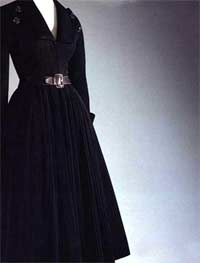
Dior dress from Fall/Winter 1950
The first years after World War II might be regarded by fashion historians as a period of transition, a period of groping after the lines into which fashion would settle for an 8-year or 10-year span.
The year 1950 could be seen as continuing the transition. Fashion remained deliberately fluid, throwing out feelers in all directions, when they all swing one feelers were cast in the direction of the 1920s, especially by Hardy Amies in London, who showed suits with straight unbelted hip-hugging jackets over straight skirts.
In Paris, too, Dior launched a “vertical line” — sheath dresses whose narrow straightness was emphasized by fine pleating or tucking, or by narrow ribbon bands running from neck to hem. Sheath dresses prevailed for day and evening.
The basis was a figure-fitting sheath, but only in certain instances was this left in a simple, uncompromising form. In general, the narrow line was broken by a jutting sash, a hip bow, an apron skirt, a floating scarf or, for evening, draped complications at hip level.
Another trick for taking the eye off the sheath skirt was the use of transparent fabrics for overskirts and for coats.
In 1950, we see the first Pierre Cardin collection.
Simple tailored coats in chiffon, lace and organdie floated over narrow summer dresses. Loose coats in thin silk were worn over suits, and the prettiest evening coats were those which added no whit of extra warmth but floated with the transparent buoyancy of balloons over narrow or crinoline evening dresses.
Although the straight hip-hugging jacket did not seem to make much headway in its extreme form, modified versions of the same feeling were seen in the prevalence of low buttoning and low-placed pockets. Many suits were open to the waist, and buttoned importantly below it. Revers became almost waist-length, leaving a horse-shoe opening over a blouse.
In the spring Dior first showed a dress slim to the knees and then breaking into pleats which developed by the autumn into the full flare of the trumpet skirt. This, in day and evening versions, swung in heavy pleats or stiffened flares, from knee-level, below the simplest of sheaths. When skirts remained narrow, as did the majority, jackets took to flaring out above them from a once-more nipped in waist, and tunics with bell-shaped peplums cut across their pencil straightness at mid-thigh level.
The vertical look changes to diagonal by autumn
Pleating and tucking, seaming and buttoning, wrap-overs and scarves, all took this diagonal slant. Scarves swelled during 1950 into the proportions of a stole, often a stole so big that it was a wrap in itself. By day, collars had scarf ends that slanted diagonally across the bodice to be pulled through a belt.
Stoles a yard wide and three yards long had their great bulk wrapped around the shoulders of suits, or hung from the neck like jacket fronts, ending in deep pockets.
By night, stoles to match or contrast with the dress fell to the hem, while others ended in fur cuffs or in gloves which held them across the shoulders. The summer’s billowing look of transparent fabrics found solid expression in the most memorable clothes of Balenciaga’s memorable autumn collection, in which taffeta appeared to have been blown up into pumpkin skirts and vegetable-marrow sleeves.
By autumn the box jacket had curved into the short barrel coat, cut away in front. “Little top-coats” became an important fashion feature. Anywhere from hip to 7/8th length, they were more than jackets, less than full-scale coats.
Some were belted and flared in a tunic line; others had a barrel curve; others hung straight almost to the knees; others swung loose. Of the full-length coats, the newest in line were the straight and narrow, sometimes held by a single, off-center buttoning, sometimes double-breasted.
Important double-breasted buttoning was also seen on the skirts as well as the bodices of suits and dresses; altogether there was a great impression of plain tailored buttons being lavishly used on all types of day clothes to emphasize the line.
Fur makes a comeback in 1950
Fur trimmings were back! But this time with more taste and restraint. Deep fur cuffs would be the only fur touch on a cloth coat; the collar would be small and tailored.
By contrast, a coat with cossack collar in astrakhan would have plain uncuffed sleeves. Fur linings, often showing themselves in turn back revers, bulked “little top-coats.” Linings attracted a great deal of notice to themselves.
The many reversible fabrics demanded a handling that would display both their sides and not only jackets but skirts and sleeves were slit to show contrasting linings; sober coats of black, brown and grey swung open to reveal bright and shiny interiors.
Fashion in 1951
In 1951 the fashion world seemed unsettled on exactly where the waistline should be. Many designers, especially Dior, employed various techniques that brought the waistline higher.
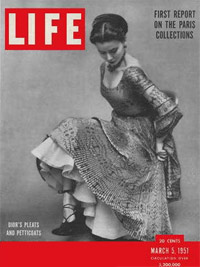
Life Magazine cover featuring Dior
A higher waistline gave the dress a longer look, when in fact most hemlines had only dropped about an inch.
Balenciaga went the other direction and took on a 1920s look, but it didn’t catch on like he’d hoped.
Many women went a different direction altogether, piecing together their own postwar look with wide skirts and tailored suits.
The wide look was accomplished by all-round pleating, flares and stiff crinoline petticoats. This fashion was first seen in American ready-to-wear collections and then later made its way back to Paris.
Remarkably, the United States was setting fashion trends around the world. The “American Look” especially appealed to the young.
In 1951 designers focused most of their efforts on innovating the sleeve. Shoulders were smooth, but some sleeves swelled drastically. Others jumped out in fans or tiered pagoda ruffles. Classic suits had three-quarter bell sleeves.
1951 also saw the return of the redingote as many women finally left their tent coats in the closet.
What kind of clothes did people wear in 1951? Here is a list of some common 1950s clothes:
- Tailored tweed dresses
- Fur trimmings (Persian lamb, ocelot and civet cat)
- Short decollete dresses with cover-up jacket or bolero
- Ankle-length dinner dresses
- Overcoats made of shaggy material
- Wide brimmed, shallow crowned hats
- Small daytime hats adorned with jewels
- Brooches
- Inch-high Cuban heels
What were the most popular colors in fashion in 1951?
- Charcoal gray & gunmetal
- Several types of greens (from emerald to dark fir)
- Blues (in the turquoise to peacock range)
- Royal blue & black combo
- Purple & lavender
- Orchid pink
Fashion in 1952
What kind of clothes did people wear in 1952?
No final answer to questions about the waistline was given in 1952. The phrase “the wandering waistline” was coined at the Paris spring collections and the waist continued to wander to the point of disappearing, throughout the year. High waist, low waist, natural waist, no waist: all had their devotees. The two main camps continued to be led by Dior and Balenciaga.
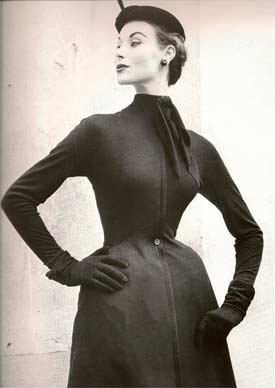
1952 Dior Dress with prominent waistline
Dior’s markedly high waists melted, as the year went on, into a development of his earlier princess dresses a molded figurine line, which followed the figure as closely as a swim suit from high neck through waist to hips, and then flared gently.
Otherwise, one designer after another forsook the Dior high-waist camp, and went over to Balenciaga, who put all his strength and authority behind his slack-waisted dresses and middy-line suits. His clothes developed a wonderful ease, being cut just not to touch the body, in contrast to Dior’s which never lost contact with it.
Each line called for a different type of corsetting, a different figure, a different posture, a different personality. Whether the two could continue to exist side by side or whether one would eventually triumph over the other remained to be seen.
It seemed that, since the end of World War II, fashion was taking a long time to settle into an accepted form which would stand, historically, as the look of the mid-century; but maybe it was part of the character of the time to allow this latitude for women to suit themselves instead of forcing them into a mold that might be suitable or unsuitable.
An evening gown by Griffe (Paris) would be in shell pink chiffon with a harem skirt that flows straight from high draped bust.
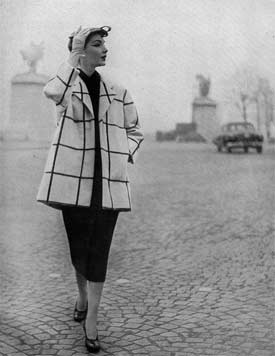
1952 Balenciaga with No Waistline
Interesting adjuncts to the waistline controversy were a legion of boleros, spencers, minute hug-me-tights; deep yokes, with pretty feminine pleating breaking from them to form an entire dress; belts low slung at the back or following the hemline of jackets; belts buckled across the chest or, on the contrary, cummerbund belts, wide or elasticized, the better to grip the midriff.
Day necklines ranged from the turtle or polo and the high straight Chinese neckband, to the draped cowl and the deep wide round scoop, which was first used for cocktail clothes but came to be seen increasingly for informal dresses. Even suits had deep standaway necks, sometimes filled in with a ribbon tie, a scarf or gilet, but sometimes bare.
Coats narrowed from the sheltering tents of earlier seasons. Loose coats hung straight without surplus fullness and there were many fitted princess coats logical over the molded figurine dresses.
Skirt lengths dropped an inch or maybe two, till 11 inches from the ground was the pronounced length; but here again women suited themselves and slightly varying lengths were seen, permissibly. The trumpet skirt shape kept narrow till mid-thigh and then, breaking into flares or deep pleats, invaded even furs.
Speaking of furs the 100% purchase tax on a fur-trimmed garment had kept fur-trimming to the minimum. With the reduction of this tax to the normal level, fur trimming rushed in. Fur collars, cuffs, pockets, bands and linings abounded; together with fur muffs, stoles and capes. Fur fabrics improved enormously and made luxurious linings in couture clothes and whole coats in the ready-to-wear ranges.
The newest and most characteristic hats of the year were the bathing-cap hats, hugging the head and at their most pronounced swallowing every vestige of hair. The young and beautiful wore them rejoicing, bandaging their heads with jersey, satin or velvet in lines which extended the shape of the head at the back. Those less favored in features consoled themselves with little flat top-of-the-head pancakes or modified pill-boxes, or big-brimmed summer straws: another example of fashion’s leaving a wide freedom of choice to the individual.
The short evening dress divided into two main types. There were the day-length dresses, usually narrow sheaths, with strapless, halter or camisole tops covered by matching boleros in dark colors, for wearing at the theater or the restaurant dinner. And then there were the short dancing dresses, with bouffant skirts falling to around ten inches from the ground. These last began to be seen at young weddings sometimes for the bride, but more often for the bridesmaids.
neck, but the strapless look remained firmly established especially for crinoline dresses
Cocktail clothes began to change character through the introduction of softer fabrics notably lace and crepe. Path’s fine jersey sweater over a crystal-pleated lace dress was a new and refreshing note. But the newest-looking skirt Dior’s square Infanta shape was earned out, of necessity, in the stiffest of moires.
In the matter of fabrics, there were many developments to celebrate. The slub weaves were supreme: the Donegals, the nubbly woolens and linens; the shantungs. Tweeds swept the field for autumn: sophisticated pebbly tweeds which came to town in a big way especially in black and white.
Fabrics and designs somewhat eclipsed in recent years, but now staging a spectacular come-back, were chiffon, crepe, lace and all the prints: notably dark motifs on a dark ground, blurred flower prints, and a striking series of prints with fur markings which brought prints well into the winter picture.
In colors the chief basic shade was grey, especially in its darker reaches; all the sherry colors from pale to dark; the butter colors, the blonds.
There were innumerable greens, ranging from palest almond through olive to bottle and fir green. White carried off special honors: white pleated crepe for day, white lace for afternoon; a cloud of white dancing dresses, long and short; white coats over dark dresses; little round white snowball jackets; and white touches by the million including white hats and not only for high summer, but far into the winter. There were good blues in the turquoise and Chinese range, with peacock and kingfisher for accents.
The lilacs and the lavenders made a pretty show, and so did the wild-rose pinks for evening.
Formal shoes became even lighter and more delicate, till they were only held to the foot by a cobweb of straps. Stoles multiplied and flourished, in every fabric for every occasion: the newest being ring stoles, just shoulder width, in everything from fur to lace.
Blouses became so important that they emerged from under the shelter of suits and functioned on their own, linked with their skirts by beautiful belts.
In 1952, the Italian fashion shows known as Sala Bianca are launched in Florence, Italy.
Men’s Fashions
The outstanding trend in men’s styles during 1952 was the almost complete abandonment of the matching waistcoat, in favor of a garment in a complimentary or contrasting color for wear with the two-piece lounge suit for business and semi-formal occasions. In a variety of materials including silk, velvet and corduroy, these waistcoats made a big contribution towards more brightness in men’s apparel, a trend which gained momentum during the year.
Bolder designs and colors on shirts, socks and ties were to be seen in even the most conservative quarters.
The fashionable double-breasted lounge suit had the jacket in button-2, show-3 style, with fairly long collar and lapels. Sleeves, often, carried turn-back cuffs, and the trousers had no turn-ups. In single-breasted suits, the vogue was for a rather low-waisted, button- 1 style. The shoulders were wide and sloping and the pockets were cut straight or slightly on the slant. Trousers were quite narrow.
For leisure wear, the corduroy jacket was much in favor. With side vents and jetted pockets, it was worn with worsted trousers with deep turn-ups. Crepe-soled suede shoes and a light-weight cap or a hat matching the color of the jacket completed the picture.
The once utilitarian raincoat came into its own as a fashionable garment. Tailored in several new proofed materials, in a variety of shades, and with a detachable lining for the cold weather, it took the place of the wool overcoat in many quarters, as the correct attire. About half of the men still wore hats.
Fashion in 1953
What kind of clothes did people wear in 1953?
1953 ushered in a mood of sleek, slender elegance — at once young and sophisticated. Hemlines, waistlines and hairlines all grew shorter. Buzzwords at the time were “shape” and “sheen.”
The waistline relaxed from the hipped tiny span that accompanied the full silhouette of the two previous years. The semi-fitted suit with a narrow jacket very slightly indented at the waist and the form-fitting sheath dress were introduced. Many dresses were beltless, although wide sashes and draped cummerbunds were popular.
Skirt lengths aroused world-wide controversy in the media. Beginning the year at an average height of 13 inches above the ground, they suddenly rose to 14 to 15 1/2 inches from the floor.
This was typical of fashion though. The hemline gradually moved up one inch per year every five years and then it moved back down and started all over again.
The “Italian” haircut, covering the head in short layered locks and with carefully casual tendrils brushed forward around the face was the successor to the shorter, curlier “poodle” cut.
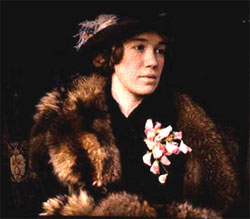
Woman Wearing Fur Stole (1953)
Young women continued to wear crinoline petticoats under extra-full skirts and clasped their waists with wide leather belts or cummerbunds.
The form fitting silhouette was softened by distinct bulk at the top, by a back-flaring profile line and by necklines opened wide in a cuff or fold around the throat and chest. Those wide open necklines were filled in with multiple strands of pearls or soft scarves.
Slacks at home were tapered to the leg like Edwardian trousers, long shorts were tailored of fine flannel. Bathing suits were either seductively molded to the figure or made like little girl rompers.
Accessories were sumptuous, frivolous and alluring. Very bare shoes with jeweled heels, toes or instep bands were a colorful addition to evening clothes. The most typical and universal accessory was the stole, which was work with suits, dresses and evening clothes. They were long and wide and made of cotton, wool, silk or fur.
Large hoop earrings were a big deal in 1953.
The natural look of makeup had one important exception in the vogue for the doe-eye. A fine penciled line edging the entire eye and extending in a slant to the corner, the elongated eye enjoyed great popularity.
Norman Hartnell designs Queen Elizabeth II’s coronation gown.
Fashion in 1954
What kind of clothes did people wear in 1954?
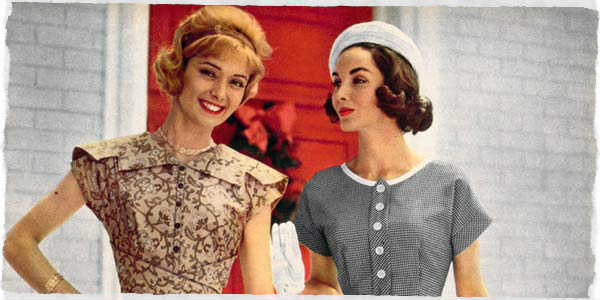
Fashion changes seemed to be following a seven year pattern as the dynasty of the full skirt and tiny waist had come to an end. 1954 wanted a prominent, pointed bosom and a straighter, softer silhouette.
Many U.S designers featured relaxed waistlines, placed less importance on the bust and placed belts, sashes and drapery at the hip. The intent was to give the appearance of a longer torso.
Dior presented the H-line, which had a silhouette relatively straight from shoulder to hip. His designs were strikingly different, raising the bust nearly two inches.
1954 fashion was marked by a subtle, elegant mood. Soft and often brightly colored, high quality fabric was in high demand.
The costume look was in full swing in 1954. Coats nearly always came with matching dresses and jacket costumes were accompanied by specially designed overblouses. Jackets came in varied lengths, with shortest a bosom-high bolero and the longest was aptly named the “skyscraper jacket,” designed by Ben Zuckerman.
Some necklines rose in the front, but dropped to almost nonexistence on evening dresses. The jumper became just as important as the blouse and skirt. Slacks were shorter and shorts were longer. Long sweaters were worn over skirts and pants.
Longer necklines and colored beads made costume jewelry heavier and more noticeable than it had been for several years.
Hats remained small, but would do a number of things to form a pronounced, uneven shape. Some hats would come to a point, while others might shoot out in the back. Fur was another accessory that saw a resurgence, back from its own seven-year lull.
Irish linen and silk were easily the two most desirable fabrics in 1954. Now that Irish linen had been made wrinkle-resistant, it was even more sought after than before.
High fashion had not quite adopted the so-called miracle fabrics, but everyday people loved to wear Orlon sweaters.
Prints enjoyed their own comeback, with people sporting patterns on all kid of fabrics like cotton, organdy and silk.
Popular colors in 1954 include ivory, Celadon (a greenish color), blue and pink. People also loved paisley and plaid, but in exciting new color combinations. Brown was the most popular basic hue.
Fashion in 1955
What kind of clothes did people wear in 1955?
In 1955, women’s clothes had a simple, young and sexy appeal. There were flavors of the 1920s thrown in, but it was done in a subtle, contemporary style.
Women loved sheaths and rarely wore belts. The bosom line was high and round, the hipline often carried accents, such as sashes.
Fashion in 1955 was heavily influenced by Asian design; Japan and India in particular. Tunics were very popular, making their presence felt in collections ranging from Charles James to Givenchy. By the fall season, the “oriental look” was the definitive silhouette.
In keeping with the Asian theme, Indian saris and Persian brocades were sold by the thousands.
Designers also made an effort to widen the shoulder without padding. Many were able to do so by giving tailored sleeves a small rounded bump at the top.
Casual clothes were more popular than ever before. While fashion houses were still very much focused on couture, the everyday wardrobe held an important place in the fashion world.
But women still loved to get dressed up! And when they did they wore the long evening dress, instead of the short dress that had been popular in recent years. Ball dresses were not too long, but not too short. Evening dresses were often made in sheer wool chiffon or thin wool jersey, mingled with gold.
In fact, the desire for fancy fabrics had not waned one bit. Thistledown was stressed in woollens and tweeds. Some woollens were even woven with mink, sable, angora or cashmere.
Blazer stripes, with bold and contrasting hues, were seen in all types of sports clothes. Young people loved plaid.
Fur finally cemented its comeback. Women loved mink and sable edged evening coats in 1955. Evening coats (with wraps) were very important in a woman’s wardrobe that year.
Because of the heavy Asian influence, fashion in 1955 is easily distinguished by its wide variety of unexpected colors. All shades of red were popular, as well as emerald green, deep yellows and sapphire blues. Once again, brown was the choice for basic colors.
Fashion in 1956
What kind of clothes did people wear in 1956?
Fashion in 1956 took a sharp turn to the more elegant and intricate. For the last couple years women had been wearing simpler designs, but in 1956 they wanted something a little more classic, more personal and more formal.
This formality was exemplified by the use of softer colors with an almost candy-box flair, the noticeable stress on softly clinging fabrics such as silk, satin and chiffon and the return of froufrou: ribbons, jabot frills, fur trim, feathers and roses.
A major influence on U.S. fashion was the Broadway musical My Fair Lady, which focused on the whimsical styles of the pre-WWI period. Juxtaposing this wholesome look, however, was the popular spy costume which consisted of a slinky, black, long-sleeved dress with plumed hat or bejeweled turban.
The Asian look, which had been so important in 1955, became even more popular in 1956. This style had not changed much from the year before; sapphire blues and emerald greens were still the most common colors.
Designers tried to replace the jacket with all types of capes, while sports clothes took on a more “boyish” look. This was accomplished by a more slender, straight and narrow silhouette.
Many women looked for clinging fabrics such as ribbed cardigans and knit sweaters. The bulky knit coat sweater and full-length coat were popular daytime choices.
Furs were still still popular in 1956, mostly as collars on tailored suits, evening dresses and coats.
Fashion in 1957
What kind of clothes did people wear in 1957?
As one fashion writer put it, 1957 was the year in which Gabrielle “Coco” Chanel (at age 74) became “an adjective in her own time.” Sort of like “Googling,” Chanelisms had been creeping back into fashion ever since the lady emerged from retirement several years before, but in 1957 they were ubiquitous.
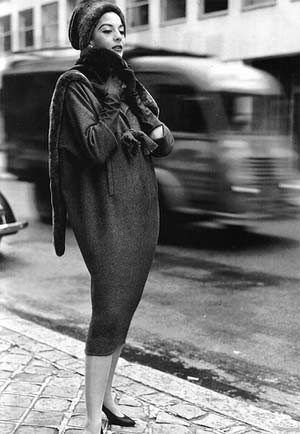
1957 Sack Dress
Short, non-fitted suit jackets often strung with brass buttons and pockets, almost always opened to show the blouse inside; sleeves peeled back to show a shirt’s cuffs; magnificent fakes such as yards of “pearls” and colored stones looped round the throat, or a jeweled Maltese cross winking on a lapel; Bretons perched on the back of the head; pull-overs that matched a jacket’s lining; jerseys, tweeds, brocades; her famous lace evening dresses — all were stamped with elegant nonchalance.
Chanel’s open-jacket policy made display pieces of blouses. No longer a suit’s silent partner, but often the focal point of a costume, the “blouse beautiful” came on the scene.
Even the man-tailored shirt showed signs of softening. Sweaters softened too, as did skirts — the latter via a sash or fringe or other dressmaker detailing.
Pleated skirts came in view, too, topped often by middies (another Chanel-ism) or an overblouse. Among the most ardent devotees of the Chanel look was the American college girl, a breed famous for its fashion nonchalance — a nonchalance proved by her eager embrace of the raccoon coat vintage 1925 (it had to be seedy or it would not do) and the newly revived Shetland sweater.
The biggest bombshell of 1957, however, burst just four months before the year ended when Paris, led by Christian Dior, ushered in the shift. It was, tragically, the last of his surprises. Dior died in October, and was mourned as one of the world’s greatest designers. Saint Laurent was appointed Dior designer.
A dress that bypassed the waist completely, it was actually the climax to a long-evolving “relaxed look” that was everywhere gaining favor. This caused huge publicity unequaled since 1947 when Dior introduced his “New Look.” Ribbons, buttons and bows achieved new importance with the disappearance of waistlines.
The best news about the new fashion for many men who bemoaned the disappearance of the female waistline was that it meant higher hemline. And that in turn meant the longer the leg, the lower the heel of the shoe, and women finally started climbing down from the stiletto heel, but still clung to the stiletto toe.
Their stockings often reflected the shade of the shoe. Hats were reduced to head size, with Bretons, berets, cloches, and slouch hats very popular. So were turbans, tipped back from the face. Gloves grew longer, past the wristbone on to opera length.
The vamp was back. Nonslinkers chose satins, brocade-stiffened fabrics that belled rather than fluttered. The cloche hat, hidden waistline and pleated skirt were prevalent in 1957 fashions.
Fashion in 1958
What kind of clothes did people wear in 1958?
Fashion in 1958 was very much focused on changing the shape of the silhouette. While many hated the loose fitting sack dresses, designers scrambled to come up with a replacement. The triangular “trapeze” shape was introduced next, but still considered too extreme for many women.
However, women were very excited about the new looser fitted clothing and rushed to buy them in the spring, but the fad died midway through the summer.
Designers also made more effort to accommodate various shapes and sizes of women. No longer would a one-shape-fits-all approach work. Tops were soft and skirts fell smoothly to a tapered hem.
Coats also followed the chemise or trapeze shape, with wide collars and buttoned front. Suits were unfitted with jackets typically grazing the hip, while being cut without flares. Suit skirts were straight and form fitting, tapered and pleated.
Hats, shoes, hair and fur were all quite important in the 1958 wardrobe. A wide variety of hats, often tall and set back on the head, were worn in various settings.
While fox, lynx and black-dyed mink were hot items, Chinchilla established itself as the preferred luxury fur in 1958.
A popular campus outfit might consist of a long, bulky sweater over top of a skinny skirt or pants. Synthetic fabrics such as Orlon, Dacron and Acrilan were all being met with greater acceptance.
The epoch of vibrant color still carried on strong. Popular colors included bright yellow, vibrant blue, violet (ranging from mauve to royal purple), emerald green, and reds (including magenta, pink and fuscia). The popular basic color was sandy beige.
Fashion in 1959
What kind of clothes did people wear in 1959?
In 1959 many designers created new silhouettes by folding large pieces of fabric around the body. Necklines took on sweeping angles, creating a dramatic geometric balance around the shoulders and throat.
The Garbo look was briefly expressed by the use of blonde fabrics, long-haired furs, loose-sashed jackets, polo coats and deep swagger hats.
The chemise and sack dresses which took over 1958 did not die out completely in 1959, but it was certainly on its way out.
By the end of 1959 the wide leather belt had returned to fashion. Around the same time Dior reintroduced the hobble-skirt.
Chanel was still wildly popular. Her casual, open, hip-length blazer jackets were imitated by almost everyone.
1959 witnessed the fall of the short jacket on suits as women preferred longer, slimmer jackets.
Fabric and trimming provided a sense of luxury. Furs such as mink, sable, leopard, fox, chipmunk and even tiger and sebra were sold worldwide. If the evening dress were not made of metallic brocade, velvet or satin, then it was certainly covered in sequins.
High hats, worn straight or far back on the head, covered most of the wearer’s hair. Shoes changed from pointed toe and high spike heel to rounded toes and moderate heels in 1959.
What were the most popular colors in fashion in 1959?
- Taupe and olive green
- Bold contrast in large areas (black/white)
- Brown
- White
- Victorian patterns







